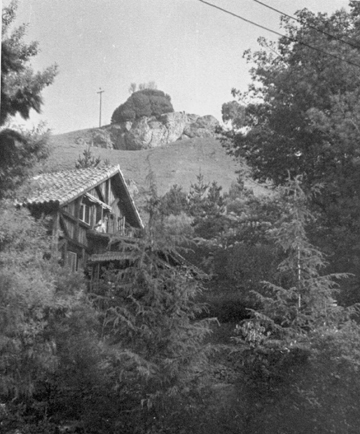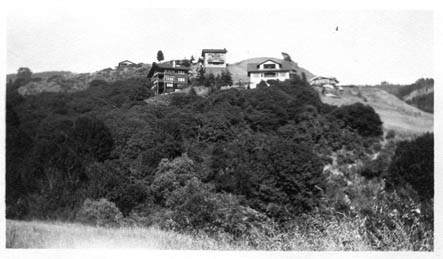|
TAMALPAIS
AND SHASTA
May 11, 2003
|
|
Berkeley's Upland Residential Park
|
|
This year's tour will take us to Tamalpais and Shasta-not the mountains
themselves, but the hilly North Berkeley streets that are their namesake.
Here you will discover one of Berkeley's most scenic wooded enclaves,
set on a hillside above Codornices Park and replete with artistic homes,
each a personal expression of the "building with nature" philosophy.
This is the best preserved and perhaps the quintessential of the neighborhoods
where the homebuilding ideals espoused by the Hillside Club flourished.
The Hillside Club was founded in 1898 to "protect the hills of Berkeley
from unsightly grading and the building of unsuitable and disfiguring
houses." In the 1890s Berkeley's hillsides began to be built upon,
and the first houses were the typical white-painted Victorian cottages.
Framed by their picket fences, these houses had an appealing charm on
Berkeley's "village" streets, but set against the tawny hills
for all to see, their inappropriateness to that locale was immediately
apparent. Club president Charles Keeler, architect Bernard Maybeck, and
members of the Hillside Club sought to remedy the situation by encouraging
prospective homebuilders to follow certain tenets for hillside construction
and design, later written down by Keeler and published as Hillside Club
Suggestions for Berkeley Homes.
|

|
| "Simplicity and genuineness," the use
of "simple, natural materials" such as unpainted wood shingles,
and "low houses" with overhanging eaves and porches "large
enough to be used as an out-door sitting room" were all encouraged.
As well, they asked that roadways follow the natural contours of the land. |
|
Tamalpais and Shasta roads were opened in the spring of 1905 as the "Hopkins
Terrace No. 4" subdivision by the Berkeley Development Company and
their agents, the Mason-McDuffie Co. One can surmise that Duncan McDuffie,
the visionary partner in the two firms, had a large hand in the design
and promotion. The rather prosaically-named tract was billed as "Berkeley's
Most Beautiful UPLAND Residence Park," and, here, the Hillside Club
Suggestion for contoured streets was utilized to great effect. The roadways
of Tamalpais and Shasta respect the topography with a zeal that perhaps
also reflects Duncan McDuffie's own conservationist thinking, formed during
his summers, hiking in the Sierra. The concept of a "residence park"
was refined and enhanced in the firms' subsequent subdivisions, such as
Claremont (later in 1905) and Northbrae (1907)
.
|
| While Claremont was marketed to San Francisco
businessmen and their families, Hopkins Terrace No. 4 seemed to appeal to
the more Bohemian Berkeleyan. The names of the streets may have been chosen
not only to reflect the hilly topography, but to capture the imagination
of Hillside Club followers. Three streets appear on the subdivision map,
filed May 15, 1905: Tamalpais, Shasta, and Tallac (later subsumed as a continuation
of Tamalpais). Mt. Tamalpais was then a "destination" for outdoors-loving
Berkeleyans who enjoyed a weekend "tramp" over its slopes to the
ocean beyond. The mountain dominates the view from the tract: "No spot
on Berkeley's hillsides commands so wonderful a sweep of bay and city."
Tallac, a prominent peak in the northern Sierra, loomed over the Echo Lake
encampments of old Berkeley families. Many were involved in the Sierra Club,
promoting an awareness of the untamed Sierra landscape, both for enjoyment
and for the need for protection and conservation. Mt. Shasta, the snow-capped
volcano rising from California's northernmost plain, was a favorite subject
for California painters. Berkeleyans displayed in their homes the dramatic
vistas by the artists of the day, perhaps painted by themselves or their
friends. |
| The "Upland" tract, Hopkins Terrace
No. 4, was a "dream tract" where artistic, intellectual, and conservation-minded
Berkeleyans could build their own vision of a "Simple Home" on
a homesite of unsurpassed beauty. And here, "embrac[ing] the grassy
slopes and wooded canyons," are some of the most individual and unusual
interpretations of the Arts and Crafts movement that can be found in California.
But the lure of "Tamalpais and Shasta" today is not only its evocative
architecture and romantic setting. The people who settled here and created
a close-knit community of hill-dwellers seemed to capture the very essence
of the creative and intellectual spirit expressed in the phrase "Athens
of the West." Attracted to the site were painters, musicians, architects,
city planners, poets, writers, "independent women," and University
professors -as well as businessmen and others from the "everyday world,"
who, nonetheless, followed a Bohemian bent. Many who arrived on the hill
never left; it is not uncommon to find today homes still occupied by third
or fourth generation descendants of the original owners. |
You will learn the stories of these early homebuilders
on the tour. Included among the places you will visit are a compound of
rough-hewn cottages set in a steep hillside garden-one for the man, one
for the woman, one for the first wife-where all lived in communal harmony;
and a group of idiosyncratic Craftsman homes designed by a woman with much
the same type of living scheme in mind. But within the cultural milieu of
"Tamalpais and Shasta" can be found contrasts of style. A gracious
Spanish Colonial residence by architect Walter Ratcliff shelters a tranquil
garden in its wings. The spacious living room was intended as a music salon
with a staircase allowing musicians a grand entrance before an assembled
audience. In yet another grand room for entertaining, designed by Greene
& Greene, Pablo Casals was often guest as well as performer. Nearby,
an owner-built, redwood cottage-designed with the neighborly advice of Bernard
Maybeck-housed a large family. One daughter became an architect, later designing
a house for her in-laws across the road.
We are certain that, as you wander the narrow roads and visit the residences
that will be open on May 11, you will feel the resonance of culture and
traditions that have been carried forward by each succeeding generation
who has called "Tamalpais and Shasta" home. |
Please make reservations for the "TAMALPAIS
AND SHASTA" tour by printing and mailing this form.
-
Don't forget to enclose a stamped self-addressed
envelope to expedite your order! Send to:
BAHA HOUSE TOUR
-
P.O. Box 1137
-
Berkeley, California 94701
Please send me tickets at $30 general $25 BAHA member
|
|
JOIN BAHA TODAY! Your annual tax-deductible membership
dues include
newsletter subscription and announcement of all activities. $25 Individual
$50 Household $5 Low-Income
NAME TELEPHONE ADDRESS CITY ZIP
Enclosed is my check for a total of $ made payable to BAHA.
|


